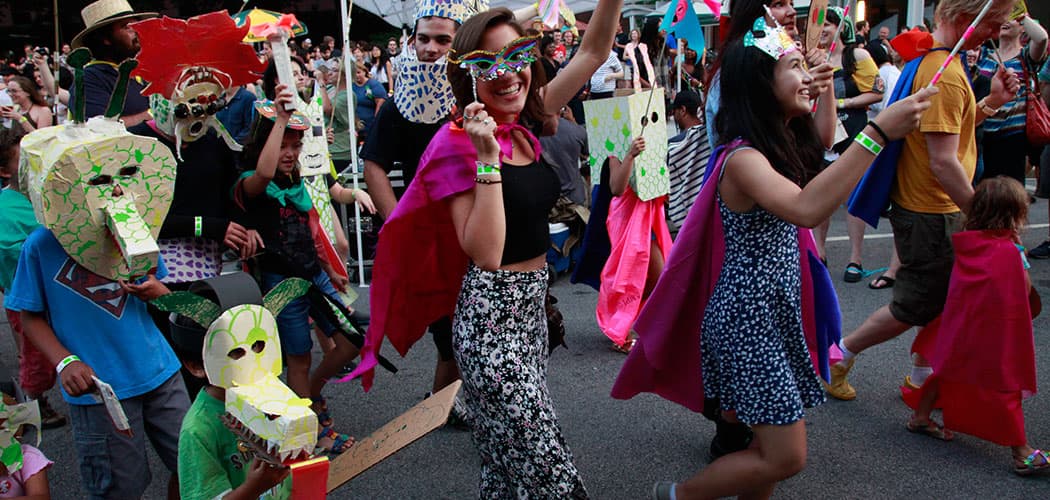Advertisement
How Foo Fest Became An Extraordinary Music And Arts Festival For Only $10

Foo Fest, the annual music and arts extravaganza from AS220, Providence’s artist-run alternative arts empire, is striking for a number of reasons. First, there is this lineup for the Aug. 8 event: headliners Deerhoof, with their distinctive blend of pop and experimental zaniness; local headliners The Low Anthem and Death Vessel; and numerous Rhode Island-based supporting acts who run the gamut from noise to hip-hop to folk rock. Then there’s the price: $10 for the whole day or $7 in advance, with kids 10 and under admitted for free. And finally, there is the plethora of crazy, weird activities and happenings, like the giant cardboard, foot-powered school bus that headed up a parade of exuberant masked festival-goers at the 2014 event.
Boston, with the success of Boston Calling Music Fest, the advent of Outside the Box and the proliferation of Porchfests in Somerville, Jamaica Plain and Roslindale, has recently upped its music and arts festival quotient considerably. But Foo Fest is a rare breed; it has the pop-minded draw of a big box fest like Boston Calling, but the experimental bent of a Hassle Fest, the annual underground rock festival hosted by Boston Hassle. Like Porchfest, its focus is on local artists (save for the headliner), and like Outside the Box, it mixes a variety of creative arts in an urban setting. And it’s only an hour away from Boston.
Foo Fest began in 1995 as a gala and carnival for AS220 called the Fools Ball and morphed in 2005 into a music festival and block party. But there is no formula for a successful music and arts festival. Each must develop its own identity. (It will undoubtedly be interesting to watch the evolution of Boston’s own festivals over the next few years.)
I wondered if Foo Fest might offer any tips for creating and sustaining a distinctive music and arts festival, so I asked David Dvorchak, AS220’s communications director, to spill the dirt. Spoiler alert: It involves obvious things like having a budget and a really clear vision and a commitment to involving the local community. Who knew!
“There’s a really tight budget that we come up with at the beginning of the year,” says Dvorchak. “We start planning this all out in January. And we do rely—in order to keep the price at what it is, and still come out on the other side having made some money—we do rely a lot on sponsorships. So we go out to the community ... the banks, local businesses, a lot of the alcohol we get discounted or donated from our distributors. ... And then what we make—and obviously we pay the bands and performers—and then what we make at the gate hopefully covers the huge amount of staff time and planning that goes into it.”
Deerhoof is from San Francisco, but 16 of the 18 supporting acts at Foo Fest 2015 are from Rhode Island. Though they run the gamut genre-wise, there is nevertheless an overarching sensibility; whether the music is pop-oriented or firmly outside the mainstream, it is reliably offbeat. This is thanks to the work of Jacob Nathan, AS220’s director of live arts, who curated the lineup. The fact that he was able to draw mostly on local talent to do it is due largely to AS220’s deep and sustained involvement with local musicians, including giving many their first big, public shows.
“Our policy at AS220 is that we’re unjuried and uncensored,” says Dvorchak. “So our stages—as well as our galleries, but we’re talking about live music now—our stages are available to any Rhode Island artist, performer, musician, who’s doing original work who wants to perform on them. The only requirement is that they get on a waiting list and then they can play at AS220. So we’re already in contact with huge amounts of bands just from Rhode Island alone so we already have a pool of performers we can draw on to book Foo Fest. So that takes care of the local side of things. All the local bands have played and been engaged at AS220 somewhat. So it’s good to give us a chance to put them on a bigger stage than they normally would be playing at AS220.”
Though AS220 makes it its mission to provide space for any and all, even the rankest beginners, it still attracts established artists to its stage. Providence’s surfeit of talented underground acts is no doubt enhanced by AS220’s mixing of energetic newbies with the more experienced, pushing everyone to greater heights.
While the music bill at Foo Fest is likely to draw a mostly Millennial and Gen X crowd, the festival offers all-ages activities throughout the afternoon. Though some cost extra, they go beyond your usual festival offerings, like face painting and balloon animals.
“I think what generally draws families in most of all are the artist installations and activities,” says Dvorchak. “There’s screen printing demos, there’s mask making demos, there’s a really cool photo booth that our media arts lab offers. So all this stuff that kids can get their hands on and participate in, all offered at a fairly cheap, if not free, price. And there’s also the Rhode Island Mini Maker Faire, which is almost like another festival unto itself. That’s indoors and it’s all, not just from Rhode Island, but from around the Northeast region. All independent inventors and tinkerers and makers. They all have their projects and their wares on display there. And for a lot of them it’s an interactive thing where kids can try it out and test it out and get introduced to creative DIY technology.”
The most charming thing about Foo Fest is its whimsy. When the artists involved come up with a creative idea, they go for it whole-hog. Last year Julia Gualtieri and Walker Mettling of the Providence Comics Consortium were Foo Fest’s artists-in-residence, and the results were pretty spectacular.
“[Last year] there was an advice booth out on the street,” remembers Dvorchak. “You would ask a question, and pay a nickel or something, and someone would type up your question. We built a pneumatic tube that ran up to the second floor of the building it was outside of. They shot the question up through the tube, where it shot out onto a table that was staffed by half a dozen comics artists, and they would illustrate a response and then shoot it back down, where it was displayed on the street.”
In response to the query, “How do I find a band to be in?”, the artist Mike Leslie replied: “Find the weirdest people you know, who are also somewhat responsible.”
Sound advice, for people and festivals alike.
